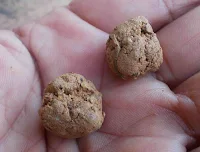When we dump the sand on the site, we do different types of field tests to check the content of silt in the sand. But once the sand is purchased from the supplier, it becomes difficult to send them back as the supplier may not agree to do so. So how about checking the silt content in the loaded sand truck before purchasing and dumping them on the site?
The following are the different methods by which you can check the silt content within a minute or two.
1. Clay balls:
 |
| clay balls found in sand. |
The clay or silt has the tendency to create lumps due to its cohesive nature. So, check out for any clay/silt lumps in the sand-loaded truck at every edge and corner of the truck. If no lumps are found, then you can proceed with the next test.
 |
| organic balls found in sand. |
You may also find some black-colored spongy type lumps in the sand. They are organic materials that come along with sand.
2. Rubbing in palm :
Take a sample of sand in your hand and add a little water if they are dry. Rub them in between your two palms for 5 to 7 seconds vigorously. Place back the sand in the truck and observe your palm. If the silt content is above the specified limit, then you will find them sticking to your palm as shown in fig. below.
 |
| silt stuck to the palm. |
If the sand has limited or no silt present in it, you will find the sand grains on your palm as shown in the fig. below.
 |
| no silt on the rubbed palm. |
3. Making sand balls :
Take a sample of sand and add water to make them slightly wet ( if dry). Squeeze them in your hand and try to make a ball out of them. If you succeeded in making round balls, then don't look back at that material.
 |
| sand making ball. |
If the sand does not stick to each other by breaking apart, then you can consider buying that sand.
 |
| sand crumbles making no-ball. |
4. Watercolor:
 |
| sand having silt. |
If the water oozes out with thick yellow or muddy color, you can say the sand contains silt or impurities in it and if the water drops out with pale yellow or transparent watercolor, then you can consider buying that sand.
 |
| sand having limited silt. |
Checking all these four methods will give you a good picture of the approximate silt content in that particular sand, and helps you to make your decision in purchasing that sand.
On the sand depot, you can do this as a comparative test for different types of dumped sand and choose the best one out of it.
Note:
These tests are not replacements for the field test and lab. test for the sand. You can say them as pre speed test before buying sand as the decision should be taken in lesser time.
After trial and error and getting some experience, you will learn to judge accurately the amount of silt present in the sand by following these methods.
To go through the field & laboratory tests conducted in civil engineering, click here.
Thank you for going through this field test ❤. Have a good day 😄.











No comments:
Post a Comment